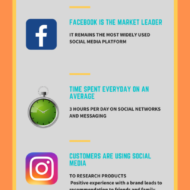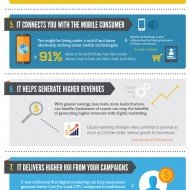Posted by Managementguru in Business Management, Marketing, SEO, Social Media, Strategy
on Feb 8th, 2019 | 0 comments

Which Digital Channels Deliver the Best ROI ? Are you in the process of finalizing your digital marketing strategy for 2019? Are you contemplating on the budget to be invested across digital marketing channels? Then read on… Before you decide which digital marketing channels you should focus on, it is but imperative that you completely understand how each one has performed for the past recent years. Just as you wanted to utilize the channels that will get you the most out of your time, you also want to make sure that you will only be investing in channels that will deliver the maximum ROI for your money as possible. Selecting the right combination of channels is crucial for ensuring the success of your overall digital marketing campaign. Digital signage has the power to improve internal communications and capture customer interest. Enplug digital signage makes it easy to scale your communications with compelling content delivered to screens across the room. The team has created a useful guide – a list of awesome tools that help users create digital signage content and other memorable visuals that could create an impact on any business. 27 Digital Signage Content Creation Tools Disruptive Shift In Digital Strategy – A Study by Ignite Visibility San Diego-based Ignite Visibility recently released a new study which highlights a growing shift in digital marketing. The study surveyed businesses in six revenue brackets – under 1 million, 1 to 5 million, 5 to 10 million, 10 to 20 million, 20 to 50 million and over 50 million – in order to gain insight into how they would be investing in digital marketing over the next two years. Additionally, the study analyzed which digital marketing channels would be most popular. “It’s incredibly important to be forecasting ahead and making sure you have the right digital strategy,” says Ignite Visibility CEO John Lincoln. “ We’re dedicated to bringing best-in-class insights to the industry so marketers can have the most effective strategy in place.” The findings reveal an overall shift toward online marketing channels across all business categories. They also reveal that many smaller businesses still struggle to effectively measure ROI and conversion rates. Furthermore, social media is by far the hardest channel for businesses to manage. “We’re seeing a large shift from offline to online because digital channels are more trackable and generally produce a higher ROI,” continued Lincoln. In the study, we also say clear divisions in the business size and type of digital marketing channel they liked the most. But overall, social media marketing seemed to be a big pain point for all marketers.” To view the full study visit Ignite Visibility (Digital Marketing Industry Study 2019) 300 Marketers Reveal Disruptive Shift In Digital Strategy Blogging remains as the top content marketing strategy 53% of marketers say blogging is their top content marketing priority. The most successful marketers spend 40% of their total marketing budget on content marketing. The average for all respondents is 26%. Content marketing revenue will exceed $300 billion by 2019. Here are some of the biggest challenges when it comes to content and email marketing. Limited internal resources 28%, lack of strategy 28% and lack of content 23%. Paid Search and Mobile Marketing As of July 2018, 90.46% of people use Google as a search engine. Bing is 3.13% and Yahoo is 2.21%. SEO leads have a 14.6% close rate, while outbound leads (such as direct mail or print advertising) have a 1.7% close rate. 18% of local searches done on mobile devices lead to a sale within a day. In 2017, 48% of 1,200 global digital marketers say on-page SEO is still considered to be the most effective SEO tactic. ...

Posted by Managementguru in Emails and Spam, How To, How to Blog, Marketing
on May 28th, 2018 | 0 comments

When done right, email marketing can provide incredible value. With an estimated ROI of $44 for every one spent, it offers marketers one of the most effective ways to spend their budget. With the potential for such high returns, many brands assume that sending more emails is the best way to get the most from this digital marketing strategy. However, as is true with many other forms of marketing, there are cases where less can actually be more. Subscribers join your email list because they’re interested in your brand and see value in the information you wish to share. If you send too much information, consumers might grow tired of always seeing your messages in their inbox. This could result in them failing to follow your CTA and just responding, or even possibly unsubscribing. Fortunately, it doesn’t require any special insight to stop customers from getting tired of your emails. Start by getting an email verifier to make sure the quality content you do send out lands in inboxes. Then, follow these few additional tips to avoid causing email fatigue among your subscribers. 1. Segment Your List Email list segmentation has been proven to increase both open and click through rates. Along with having a positive impact on these important metrics, it can also be one of the most effective ways to prevent email fatigue. Segmentation is important because your subscriber list is made up of many types of people. Different types of content may appeal to those specific audiences. When you segment your list, you can send the most relevant content to the parties that are most likely to be interested. A properly segmented list will prevent fatigue because subscribers will be receiving fewer overall emails. Additionally, the ones that they are being sent will have content that’s more relevant and interesting to them as individual users. 2. Give Subscribers Options With most email marketing strategies, the subscriber only has two options: to opt in or opt out. You should give your customers more choices than simply being on or off the list. For example, if you send different types of information, let subscribers pick the sort of content they want to receive. You could also provide users with options for email frequency or the ability to pause communications. 3. Track Email Analytics You need to develop a strategy for the frequency with which you send emails. In a survey from MarketingSherpa, 86% of respondents said they would like to receive emails at least once a month. However, keep in mind that every list is different. You need to develop an email schedule that is based on the habits and preferences of your subscribers. By tracking analytics, you can see how customers are responding to your emails. A noticeable drop in your open rates or an increase in the number of unsubscribes can both be signs that you are sending too many emails. 4. Test Your Emails Testing can be one of the best ways to develop an email strategy that will deliver good results. When you’re getting ready to start a new email campaign, develop different versions of the same email. Test differences in things like subject line, layout, CTAs, images, content, and the like. When you see what works successfully among the test group, you can then send the most effective version of the email out to the rest of your list. 5. Personalized Email Content You don’t want to send generic emails to your subscribers. With greater levels of personalization, you can deliver content that is more engaging. By leveraging information about your clients, you can learn about their demographics, behaviors, interests, and more. You...

Posted by Managementguru in How To, Marketing, Social Media
on Oct 8th, 2015 | 0 comments

As Halloween the beloved festival observed in many countries is fast approaching, the retail market is like steaming hot. Manufacturers and Marketers are on a constant roll to maximize the sales volume with a decent margin. Christmas follows suit and the market enthusiasm is never going to boil down. People will be on a “Shopping Spree” and will definitely not mind spending a few extra bucks on their purchases. So, how the retail market which is going to be the shopping hub react to this “Mega Holiday Shopping?” Holiday #ecommerce sales are important for many online retailers In some cases, small business owners might see a significant portion of total annual sales in just a couple of months. Understanding what to expect in terms of growth or trends may help with planning your holiday season. The holiday shopping season will start long before #Black Friday or #Cyber Monday. In fact, at least 25 percent of holiday shoppers in the United States will purchase a Christmas gift before Halloween. Year after year, online retail sales outpace retail sales overall, and 2015 will be no exception. But regardless of where a product is sold, it will be a good year for retail. 4 Predictions for the 2015 Holiday Shopping Season Early shopping, Ecommerce Sales Growth, Improved #email marketing, and #mobile commerce will be among the most important ecommerce trends during the 2015 Christmas shopping season, which lasts from the end of October through December 24. Two things will make email even better this holiday season First, expect to see more companies automate email messages, so that when shoppers make a holiday purchase they will see follow up messages that are designed to make additional sales and retain those holiday customers all year long. Second, email marketers are getting better at segmentation and personalization, which, in turn, should make an already effective #marketing vehicle even better. Three factors will continue to push growth for mobile ecommerce First, even more sites are responsive and mobile optimized. Having a responsive website is not a competitive advantage in 2015; it is a competitive requirement. Second, as smartphone screens get larger, mobile ecommerce becomes easier. The Samsung Galaxy S6 is 5.65 inches tall and 2.78 inches wide. The iPhone 6 Plus is 6.22 inches tall and 3.06 inches wide with a 5.5 inch HD display. On devices like these, it is simply easier to shop. Third, mobile payment options are improving, again making it easier to shop from a smartphone. Curated from 4 Predictions for 2015 Holiday Shopping Season | Practical Ecommerce How to prep your ecommerce store for holiday shoppers Even though it’s only early October, if you’re online #retail business isn’t already gearing up for the holiday season, you may miss out on revenue. So what should you and your staff be doing now to ensure your ecommerce store is able to handle the extra holiday-related traffic? Don’t make any drastic changes to navigation or layout right now Make certain your site can handle the additional holiday traffic Ensure your site is up to speed Show that your site is secure Ensure you’re properly stocked – and can re-order inventory quickly if necessary Staff up Make sure people can shop from a variety of devices Optimize images and give your site a festive feel Showcase top-rated items – and offer gift suggestions Alert customers to holiday shipping deadlines Offer live chat Add a gift-wrap option Offer free shipping Provide hassle free exchanges/returns Make checking out easy Provide a self-service option so customers can check on shipping and get answers to FAQs Curated from How to prep your ecommerce store for holiday shoppers | CIO Ultimately the customers must leave...

Posted by Managementguru in Marketing, Social Media, Startups, Technology
on Apr 8th, 2015 | 0 comments

Disclaimer: This content is curated and since information related to digital marketing is available aplenty on the Internet, I thought of compiling data in a sequential and comprehensive manner for the benefit of the readers. One of the easiest, fastest and cheapest ways for businesses to reach consumers today is via the Internet. Read on: Fed Fix: What is Inbound Marketing? This resourceful article explains essential inbound marketing strategies and tactics that companies can use to boost their campaigns’ effectiveness. Digital marketing, also known as Internet or online marketing, is quickly replacing print, television and radio advertisement as the marketing approach of choice for businesses of all sizes. Recent research revealed that 1 in 4 of every business-advertising dollar is dedicated to Internet marketing. Digital marketing uses internet connected devices such as smart phones, laptops and tablets to engage customers online via technologies such as web and email in conjunction with digital customer data such as characteristics and behaviour. Channels include display advertising, search engine optimisation (SEO) and search engine marketing (SEM). It also includes email, RSS, blogging, podcasting, video streams, social networks and instant response messaging. If you are looking for an edge over your competitors, a digital marketing strategy can provide many benefits to today’s savvy business owner. Benefits of Digital Marketing for Small Business 👇 Instant Access Wide reach to internet users in a single click. Cost Effective A well planned and targeted digital marketing campaign can help your business reach your target audience at a lower cost compared to traditional marketing tactics. Open 24/7 Your website is available to your target audience 24/7. Increases Customer Retention and Loyalty Engage with your customers in a more personalised way when you advertise your products and services. Community Building and Reputation Social media provides the perfect platform to build customer loyalty and build strong online reputation. Research Provides the possibility for an immediate response and feedback from today’s connected consumer. It’s Measurable Track your online campaign’s success in real time. Digital Marketing Channels or Campaigns Online marketing doesn’t only revolve around your website. Although this is an important part of it, you should be aware of other channels that will aid your digital marketing strategy. Whether you’re looking at low budget or blow–the- budget campaigns, these forms of digital marketing are ideal for small businesses as you can adapt your activity to suit your financial situation: 👇 Discover a huge collection of digital assets on Social Media Marketing here! 1. Content Marketing Your website is a powerful tool within your marketing strategy. Most of the time this is where you will be directing your customers to when you engage with them so it’s important to ensure you have interesting content to keep your customers on the site for longer. Start by keeping an interesting blog so that you can share relevant content with your customers and draw them to your site. With new technologies, more people are reading content on their mobile phones and tablets than ever before. It’s important to ensure your website is easy to browse and interact with on these different devices so that customers can have a good user experience on the move. 2. Search Engine Marketing Stay ahead of your competitors by driving traffic to your website using Search Engine Optimisation (SEO). It works by optimising your site to increase its organic ranking in search engine results (for example how high up you would appear in a search list on Google), so that customers will be more likely to visit your site. Search engine marketing focuses on improving your ranking using specific methods such as improving your use of keywords (words and phrases...








